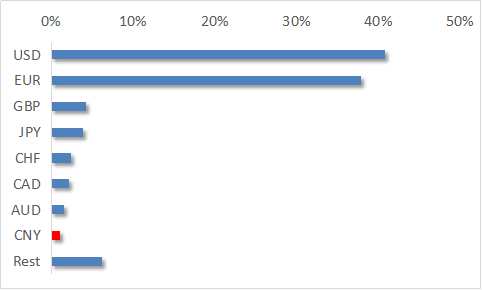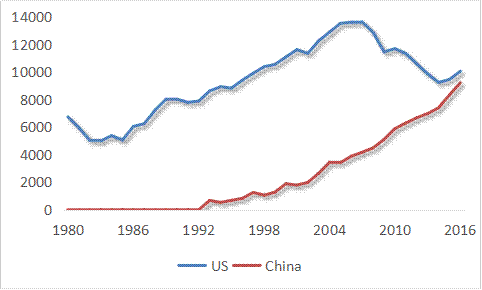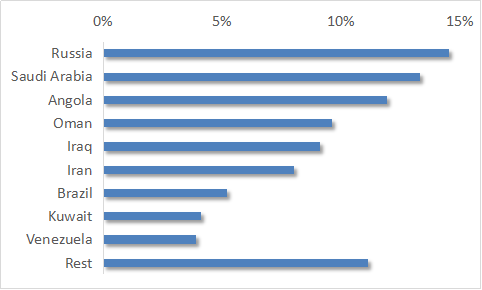The Petroyuan Shift: The Eclipse of the Petrodollar Monopoly
Currencies / China Currency Yuan Apr 11, 2018 - 10:42 AM GMTBy: Dan_Steinbock

 As oil can now be traded with RMB-denominated contracts, the rise of the petroyuan will accelerate the internationalization of the Chinese currency as investors begin to increase their allocations into Chinese financial assets.
As oil can now be traded with RMB-denominated contracts, the rise of the petroyuan will accelerate the internationalization of the Chinese currency as investors begin to increase their allocations into Chinese financial assets.
In late March, as international media focused on Trump’s tariffs and the prospects of a trade war, renminbi-denominated oil contracts began trading in the Shanghai International Energy Exchange (INE), for the first time. That will foster the rise of petroyuan, which may cause a dramatic shift in global asset allocations as institutional investors begin to diversify into China’s onshore bond markets.
Today, the status quo is still very different. The US dollar (USD) and the euro (EUR) still dominate more than 85 percent of international payments, followed by the English pound, Japanese yen, the Swiss franc, Canadian dollar and Chinese yuan (1%) (Figure 1).
Figure 1. Major International Payments Currencies

Source: SWIFT, Feb 2018
Following its integration into the global economic and trading environment, China is now integrating into the global financial system. It is already the world's biggest trading country, has the largest foreign-exchange reserves, and the world's biggest consumer market. As China now also absorbs most of the world’s commodities, dollar-denominated intermediaries are not warranted - if they ever where.
Rise and eclipse of petrodollar
After World War II, US dollar was the predominant world currency and America fueled almost half of the world economy. Today US dollar accounts for barely 40 percent of international payments while the share of the US in the world economy is less than half of what it was in 1945. So why does the US still benefit from this “exorbitant privilege”? That has nore to do with petrodollar.
After the 1945 Yalta Conference, which effectively divided Europe, the ailing President Franklin D. Roosevelt met Saudi Arabia’s King Ibn Saud. Bypassing the Brits, the former “masters of the universe,” FDR and Saud agreed to a secret deal, which required Washington to provide Saudi Arabia military security in exchange for secure access to supplies of oil.
Despite periodic pressures, the pact survived until the 1971 “Nixon Shock.” As the dire US economic prospects led President Nixon to the unilateral cancellation of the direct international convertibility of the US dollar to gold, the postwar Bretton Woods system of international financial exchange was replaced by a regime based on freely floating fiat currencies. US dollar was decoupled from gold.
To deter the marginalization of US dollar, Nixon negotiated another deal, which ensured that Saudi Arabia would denominate all future oil sales in dollars, in exchange for US arms and protection. Led by Saud, other OPEC countries agreed to similar deals and global demand for US petrodollars soared.
The US-Saudi strategic partnership weathered another four decades of multiple regional wars. When the Fed began to pave way for rate hikes in 2014, the value of the dollar started to climb, though slower than expected, and oil prices plunged since oil markets are dollar-denominated. To seal the old alliance, President Trump signed a historical $110 billion arms deal with King Salman.
Yet, US dollar's coverage is slipping because structural conditions that supported its dominance have been softening since 1971.
How OBOR drives the rise of petroyuan
The internationalization of the Chinese renminbi accelerated significantly in 2016 when RMB joined the IMF international reserve currency basket. Last October, China established a payment-versus-payment system for transactions involving Chinese yuan and Russian ruble. The China Foreign Exchange Trade System (CFETS) hopes to launch similar systems with other currencies based on China’s huge multi-decade, multi-trillion One Belt One Road (OBOR) initiatives.
As the OBOR expands links between major economies in Asia, Africa, Europe and Latin America, member countries are candidates for RMB-denominated payments. Last December, Iran, which has not deployed US dollar in foreign-trade transactions since the early 2010s, announced it would join the Russia-led Eurasian Economic Union (EEU), which will also have a central role in the OBOR, and thus in RMB-denominated payment systems. US geopolitics is escalating these trends. When the White House suspended US aid to Pakistan, Islamabad announced that the Chinese yuan can be used for bilateral trade and investment activities, which will support the Chinese-Pakistan $57 billion economic corridor.
Recently, China has become the largest global oil consumer (Figure 2). With major oil exporters like Russia, Venezuela, Iraq, Iran, and Saudi Arabia, China's market means leverage, and many of these suppliers have either already agreed to price their sales to China in RMB, or are actively considering it (Figure 3). In turn, major commodity exporters, such as Indonesia, have joined in non-dollar trades.
Figure 2. US & China Crude Oil Imports (1,000 Barrels per Day), 1980-2016

Source: BP Statistical Review of World Energy 2017
Figure 3. China: Oil Suppliers (% of Total Imports), 2016

Source: World Top Exports, March 2018
The future is on China’s side. By 2040, Chinese annual demand is expected to grow more than 30 percent, whereas US is likely to reduce its reliance on oil imports as it hopes to develop domestic shale oil capacity. US economic interests with Saudi Arabia may erode, even if military interests prevail. If Saudi Arabia decides to adopt the yuan for some of its oil exports, that could unleash a broader shift.
Impending shift
As an increasing share of China’s oil imports will be priced in RMB, that will result in large RMB reserves in oil exporting countries, which will be spent on Chinese exports, or recycled into China's financial markets. As demand for RMB assets will increase, the role of USD for trading purposes will lessen.
In the short-term, the Chinese system is unlikely to change the way oil is traded globally. Even with exchange convertibility, international investors and resource traders must have confidence in Shanghai INE as a trading hub.
In secular terms, the petroyuan will mean a paradigm shift in global asset allocations to China’s financial markets, as long as China will continue to remove or significantly reduce capital controls for RMB-priced oil trading. Between 2014 and 2017, global institutional investors already tripled their China holdings of onshore bonds. In a year or two, when China's onshore bond markets are likely to be included in global bond benchmark indices, a major reallocation of capital will flow into China's onshore bond markets.
An important caveat: The progressive shift to petroyuan will speed up disruptively if investors one day lose faith in the US dollar, due to a US debt crisis, or a huge Trump policy blunder, as the shift away from US dollar could accelerate dramatically.
China’s economic rise is already a reality. The coming shift in global asset allocations is its rightful reflection in world finance.
Dr. Dan Steinbock is an internationally recognized strategist of the multipolar world. and the founder of Difference Group. He has served as at the India, China and America Institute (USA) , the Shanghai Institutes for International Studies (China) and the EU Center (Singapore). For more, see https://www.differencegroup.net/
The original commentary was released by China-US Focus on April 9, 2018.
© 2018 Copyright Dan Steinbock - All Rights Reserved
Disclaimer: The above is a matter of opinion provided for general information purposes only and is not intended as investment advice. Information and analysis above are derived from sources and utilising methods believed to be reliable, but we cannot accept responsibility for any losses you may incur as a result of this analysis. Individuals should consult with their personal financial advisors.
© 2005-2022 http://www.MarketOracle.co.uk - The Market Oracle is a FREE Daily Financial Markets Analysis & Forecasting online publication.


